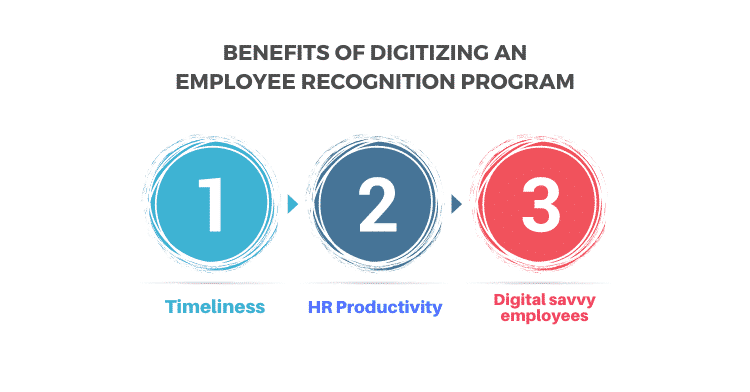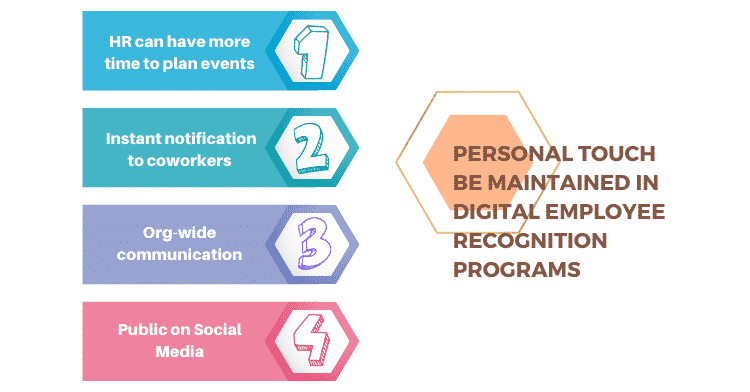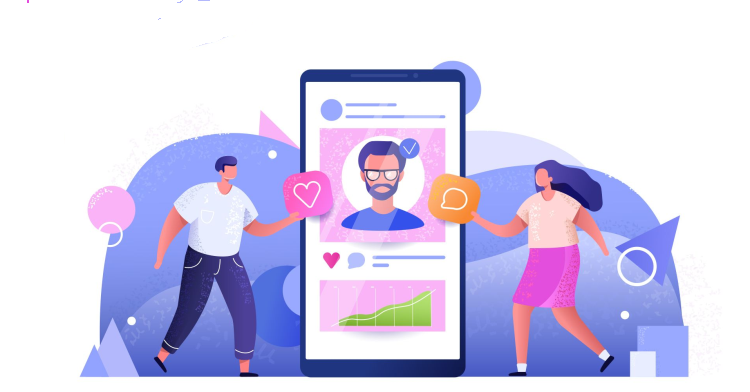1. Improves Timeliness and Efficiency: Digitization allows for quick recognition of employee achievements, reducing manual processes and freeing HR for more value-added tasks.
2. Enhances Visibility and Reach: Digital platforms enable instant notifications to coworkers, organization-wide communication through digital walls of fame, and public recognition on social media.
3. Maintains Personal Touch: HR teams can use the saved time from digitization to plan in-person events and celebrations, ensuring personal interactions remain part of the recognition process.
4. Boosts Employee Satisfaction: Digitized recognition programs provide a modern, efficient approach that enhances employee satisfaction and engagement without losing the personal touch.
Does digitizing employee recognition programs take away the personal touch and diminish their value? The answer to this question is a resounding NO!
People had similar concerns about the telephone, computers, the Internet, etc. However, as social beings, we have still managed to interact in some form or another.

1. Timeliness: Digital platforms can help recognize employee achievements quickly and drastically reduce the manual processes of data collation, approvals, procurement, and distribution.
2. HR Productivity: Eliminating manual tasks frees time for HR teams to devote to more value-added activities.
3. Digital-savvy employees: Many millennials use various digital platforms profusely, so having a traditional process is unthinkable.
While the benefits of digitization seem obvious, what about the flip side of it in terms of reduced employee touch?
Based on the experience of organizations with such digital recognition programs, we have put together these thoughts:
1. HR can have more time to plan events
2. Instant notification to coworkers
3. Org-wide communication
4. Public on Social Media


With digitization, the HR Team now has more time to plan and execute in-person rewards and recognition events.
These could be floor huddles, all-hands-meets, town halls, etc. Members of the management can recognize employees in the presence of a reasonably large gathering of employees.

Also, digital platforms can send out communication over email to other employees and teams.
Even employees on other teams or in other workplaces would be able to know it instantly as recognition occurs.
Coworkers might contact the recognized employees via email (phone or messenger) to congratulate them.

Additionally, a digital wall of fame can propagate the message across the entire organization.
It can cut through geographic, functional, and team boundaries and reach everyone in the organization.

Certain organizations allow the recognition to be posted on social media such as Facebook, LinkedIn, and Twitter.
They can post the recognition through the company’s social media handles or allow employees to share using their own.
Hence, recognition can reach the friends and family of the recognized employees, further boosting their sense of achievement and pride.

No, it doesn’t. Digital platforms enhance recognition’s timeliness, visibility, and efficiency—while freeing HR to focus on in-person interactions that preserve warmth and authenticity.
– Timeliness & Efficiency: Digital systems allow for instant acknowledgments and reduce manual effort.
– Better Visibility & Reach: Achievements can be broadcast across the organization via digital channels, social media, or virtual walls of fame.
By automating backend tasks, HR gains bandwidth to design meaningful face-to-face moments—like ceremonies, gatherings, or personalized celebrations. These ensure human connection remains central.
Yes. While some worry digital approaches may feel impersonal, modern platforms support human connection through gamification and social features that foster engagement and emotional resonance.
These features inject fun, interactivity, and shared celebration into recognition programs—making them feel more dynamic, inclusive, and heartfelt than traditional methods.
Technology supports visibility and speed, but can’t replace empathy. Managers and HR must continue expressing sincerity—through tailored messages, live moments, and personal interactions—to keep recognition meaningful.
Overall, it does seem that digitization of the employee rewards and recognition program adds much more than what it takes away. There is no reason to believe that it would reduce the personal touch.
It can vastly improve timeliness and communication, creating higher employee satisfaction than traditional methods. It is almost like comparing an airplane with a bullock cart.
Given today’s digital-savvy way of life, geographically distributed workforces, and busy corporate schedules, a digital platform for employee rewards and recognition are must-have for most organizations. No second thoughts!

Lead author: Sagar Chaudhuri, the Co-Founder and CEO of HiFives. He is an HR Tech Evangelist with over 25 years of corporate and entrepreneurship experience. In the past, Sagar has held leadership roles at companies such as Genpact, Infosys, and ICICI Bank. He has an engineering degree from IIT Kharagpur and an MBA from IIM Lucknow. Connect on LinkedIn
To stay updated on the latest HiFives blogs, follow us on Twitter (@MyHiFives)